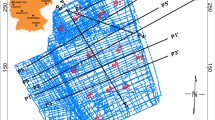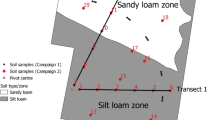Abstract
A world-wide need to use water resources efficiently necessitates more effective approaches to study water and contaminant transport in soil. This study examined the effectiveness of a multi-receiver electromagnetic induction probe (Geonics EM31-3RT) and modeling software (EMIGMA) to delineate hydrological regimes at field scale. The site consisted of 20 (15 m × 15 m) tile-drained plots in Southern Ontario, Canada. Measurements of apparent soil electrical conductivity (ECa) and magnetic susceptibility were obtained using the EM31-3RT in each plot at four distances (0, 2.25, 4.5 and 7.5 m) from the tile drain, and on three occasions (August 22, 26 and 29) in 2003. The EMIGMA was used to simulate a depth profile of electrical conductivity (ECs) from EM31-3RT readings. The near-surface soil showed significantly (p < 0.01) smaller ECa values than at greater depth. The ECa measurements made directly over the tile drains were smaller than those observed further away due to the presence of the drains. Cluster analysis indicated that the largest ECa values were at the lower elevations of the site related to the redistribution of moisture from higher elevations. The effect of tile drains and rainfall events on ECa was simulated well by EMIGMA, with smaller ECs values above the drains compared to further away, and showing an increase in ECs in the near-surface soil after rain. This study suggests that EM31-3RT measurements combined with EMIGMA simulation of electrical conductivity can provide valuable information on depth profiles of ECa and water dynamics in soil.












Similar content being viewed by others
References
Akay, O., & Fox, G. A. (2007). Experimental investigation of direct connectivity between macropores and subsurface drains during infiltration. Soil Science Society of America Journal, 71, 1600–1606.
Brevik, E. C., & Fenton, T. E. (2002). The relative influence of soil water content, clay, temperature, and carbonate minerals on soil electrical conductivity readings taken with an EM-38 along a Mollisol Catena in Central Iowa. Soil Survey Horizons, 43, 9–13.
Brevik, E. C., Fenton, T. E., & Lazari, A. (2006). Soil electrical conductivity as a function of soil water content and implications for soil mapping. Precision Agriculture, 7, 393–404.
Callegary, J. B., Ferre, T. P. A., & Groom, R. W. (2007). Spatial sensitivity of low induction-number frequency-domain electromagnetic induction instruments. Vadose Zone Journal, 6, 158–167.
Clay, D. E., Chang, J., Malo, D. D., Carlson, C. G., Reese, C., Clay, S. A., et al. (2001). Factors influencing spatial variability of soil apparent electrical conductivity. Communications in Soil Science and Plant Analysis, 32, 2993–3008.
Corwin, D. L., & Lesch, S. M. (2005a). Apparent soil electrical conductivity measurements in agriculture. Computers and Electronics in Agriculture, 46, 1–43.
Corwin, D. L., & Lesch, S. M. (2005b). Characterizing soil spatial variability with apparent soil electrical conductivity: I. Survey protocols. Computers and Electronics in Agriculture, 46, 103–133.
Crittenden, S. J. (2005). Effect of manure management practice on E. coli, phosphorus, and nitrogen loss in agricultural water. M.Sc. Thesis. Department of Land Resource Science, University of Guelph.
Dharmakeerthi, R. S., Kay, B. D., & Beauchamp, E. G. (2006). Spatial variability of in-season nitrogen uptake by corn across a variable landscape as affected by management. Agronomy Journal, 98, 255–264.
Geonics Ltd. (2002). EM31–3-1 three coil separation conductivity meter. Operational notes. Mississauga, Ontario, Canada: Geonics Limited.
Helwig, T. G., Madramootoo, C. A., & Dodds, G. T. (2002). Modelling nitrate losses in drainage water using DRAINMOD 5.0. Agricultural Water Management, 56, 153–168.
Jamieson, R. C., Gordon, R. J., Sharples, K. E., Stratton, G. W., & Madani, A. (2002). Movement and persistence of fecal bacteria in agricultural soils and subsurface drainage water: A review. Canadian Biosystems Engineering, 44, 1.1–1.9.
Kachanoski, R. G., Gregorich, E. G., & van Wesenbeeck, I. J. (1988). Estimating spatial variations of soil water content using noncontacting electromagnetic inductive methods. Canadian Journal of Soil Science, 68, 715–722.
Kladivko, E. J., Brown, L. C., & Baker, J. L. (2001). Pesticide transport to subsurface tile drains in humid regions of North America. Critical Reviews in Environmental Science and Technology, 31, 1–62.
Lesch, S. M., Corwin, D. L., & Robinson, D. A. (2005). Applications of apparent soil electrical conductivity in precision agriculture. Computers and Electronics in Agriculture, 46, 351–378.
Lukas, V., Neudert, L., & Kren, J. (2009). Mapping of soil conditions in precision agriculture. Acta Agrophysica, 13, 393–405.
McCutcheon, M. C., Farahani, H. J., Stednick, J. D., Buchleiter, G. W., & Green, T. R. (2006). Effect of soil water on apparent soil electrical conductivity and texture relationships in a dryland field. Biosystems Engineering, 94, 19–32.
McNeill, J. D. (1980). Electromagnetic terrain conductivity measurement at low induction numbers. Technical note TN-6. Ontario, Canada: Geonics Limited.
McNeill, J. D. (1992). Rapid, accurate mapping of soil salinity by electromagnetic ground conductivity meters. In G. C. Topp & W. D. Reynolds (Eds.), Advances in measurement of soil physical properties: Bringing theory into practice (pp. 209–229). Madison WI: Soil Science Society of America Special Publication No. 30.
PetRos EiKon, Inc. (2003). EMIGMA (V7.5). Concord, Ontario, Canada: PetRos EiKon, Inc.
Rhoades, J. D., & Oster, J. D. (1986). Solute content. In A. Klute (Ed.), Methods of soil analysis part 1—Physical and mineralogical methods (2nd ed., pp. 985–1006). Madison, WI: ASA-SSSA.
Robinson, D. A., Campbell, C. S., Hopmans, J. W., Hornbuckle, B. K., Jones, S. B., Knight, R., et al. (2008). Soil moisture measurement for ecological and hydrological watershed-scale observatories: A review. Vadose Zone Journal, 7, 358–389.
Sheets, K. R., & Hendrickx, J. M. H. (1995). Noninvasive soil water content measurement using electromagnetic induction. Water Resources Research, 31, 2401–2409.
Shipitalo, M. J., Nuutinen, V., & Butt, K. R. (2004). Interaction of earthworm burrows and cracks in a clayey, subsurface-drained, soil. Applied Soil Ecology, 26, 209–217.
Sims, J. T., Simard, R. R., & Joern, B. C. (1998). Phosphorus loss in agricultural drainage: Historical perspective and current research. Journal of Environmental Quality, 27, 277–293.
Soil Classification Working Group. (1998). The canadian system of soil classification (3rd ed., p. 187). Ottawa, Ontario: Agriculture and Agri-Food Canada Publication 1646.
Soil Survey Staff. (2006). Keys to soil taxonomy (10th ed.). Washington, DC: USDA-Natural Resources Conservation Service.
StatSoft, Inc. (2000). Statistica for windows. Tulsa, OK.
Acknowledgments
The authors wish to acknowledge the great contributions of Peter von Bertoldi, Paul Bacchus, Kerry-Anne Pumphrey, Andrew Olinski, Don Irvine and Steve Crittenden to the project. As well, field personnel at Elora Research Station are thanked for excellent assistance in crop management. Funding for this work was provided by Canada Foundation for Innovation and Canadian Water Network.
Author information
Authors and Affiliations
Corresponding author
Rights and permissions
About this article
Cite this article
Dadfar, H., Heck, R.J., Parkin, G.W. et al. Evaluation of a Geonics EM31-3RT probe to delineate hydrologic regimes in a tile-drained field. Precision Agric 12, 623–638 (2011). https://doi.org/10.1007/s11119-010-9203-4
Published:
Issue Date:
DOI: https://doi.org/10.1007/s11119-010-9203-4




